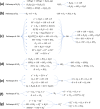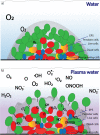Interactions of plasma-activated water with biofilms: inactivation, dispersal effects and mechanisms of action
- PMID: 33504802
- PMCID: PMC7841176
- DOI: 10.1038/s41522-020-00180-6
Interactions of plasma-activated water with biofilms: inactivation, dispersal effects and mechanisms of action
Abstract
Biofilms have several characteristics that ensure their survival in a range of adverse environmental conditions, including high cell numbers, close cell proximity to allow easy genetic exchange (e.g., for resistance genes), cell communication and protection through the production of an exopolysaccharide matrix. Together, these characteristics make it difficult to kill undesirable biofilms, despite the many studies aimed at improving the removal of biofilms. An elimination method that is safe, easy to deliver in physically complex environments and not prone to microbial resistance is highly desired. Cold atmospheric plasma, a lightning-like state generated from air or other gases with a high voltage can be used to make plasma-activated water (PAW) that contains many active species and radicals that have antimicrobial activity. Recent studies have shown the potential for PAW to be used for biofilm elimination without causing the bacteria to develop significant resistance. However, the precise mode of action is still the subject of debate. This review discusses the formation of PAW generated species and their impacts on biofilms. A focus is placed on the diffusion of reactive species into biofilms, the formation of gradients and the resulting interaction with the biofilm matrix and specific biofilm components. Such an understanding will provide significant benefits for tackling the ubiquitous problem of biofilm contamination in food, water and medical areas.
Conflict of interest statement
The authors declare no competing interests.
Figures







References
Publication types
MeSH terms
Substances
LinkOut - more resources
Full Text Sources
Other Literature Sources
Medical

